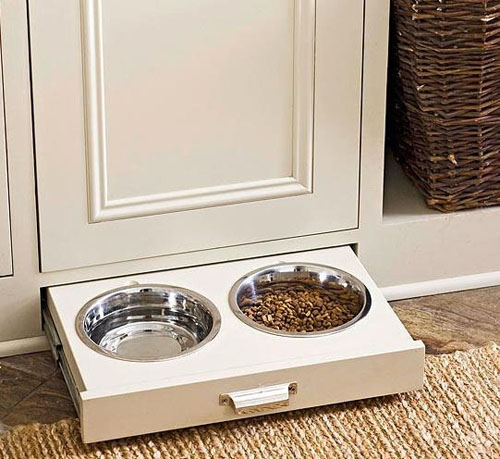How to Design a Kitchen, Part Three
Today's installment of this series is about starting with the solution.
This happens a lot with clients who have been thinking about their renovation for a while. They've got an idea of what they think the only solution to their design problem is. So instead of telling us the design problem and letting us come up with ways to solve it, they tell us that this solution they've come up with is a need-to-have for their kitchen.
For example: the problem is that their dogs are sloppy when they drink water, and it gets all over the kitchen. They've given it some thought, but the only solution they've come up with is a thing they saw on Pinterest where the dog's bowl is in a drawer that pulls out of the cabinets. So rather than tell us that this is a solution to the sloppy water issue, they show us that picture and tell us that is what they need or want.

Now, sure, that is one idea to try to address the problem. But notice a couple things:
First, this doesn't actually address the sloppy water issue. The dog will still get water everywhere.
Second, do you leave this pulled out all the time, or do you limit your dog's access to water? Neither of these seems like a great solution to me.
Oh, and third, I'm not so sure it's a great idea to put a bowl of water inside a wooden cabinet all day if you get what I'm saying.
So. Instead of finding out the problem we can actually solve, we find out the client wants a very specific kind of thing. Now we can dig into why they want it, and we do try to ask leading questions like, "what it is about this image that is attractive to you?" or "what problem is this trying to solve?" But sometimes it's not as obvious that the client is leading with a solution. Maybe they're reluctant to let go of some design control (a lot of people think an architect will go all Mies van der Rohe on them if they turn their backs for a minute). Or they've lost sight of what problem their "need to have" is solving for them.
Some examples of leading with the solution: needing a cooktop in the island (or any appliance in any specific place), needing two dishwashers, needing a built-in banquette seating area, needing to incorporate this cool idea you saw on some viral piece going around Facebook. All of these things can be specific responses to design needs, but they are all solutions rather than problems. When you can make a list of the problems you want to solve and the ways you already use your space, you can get past hanging up on one specific solution.
The thing is, when you get hung up on a specific solution, you're likely to get hung up on a lot of them. And eventually your "design" is just a patched-together hodgepodge of tricks and hacks, with no real unifying design that brings everything together. Worse, it probably leaves lots of design problems unresolved, since you aren't really even looking at the problems to begin with.
This is one reason why I have a love/hate relationship with Pinterest and Houzz. Both places are very solution-based and gimmicky. They are the source of some really great inspiration photos and those photos can be really helpful to us in pulling together a look that will thrill our clients, but I've come to cringe when they show up at a meeting with a sheaf of crazy customized cabinets (that post is coming next in this series) or other very specialized design solutions.
The thing about house design is that most people feel pretty knowledgable about how they use their house and how they want to use their house. We are all people who live in space, right? So they don't really know what kind of training and practise goes into the work of an architect. Even "home designers" -- a completely unregulated term for somebody who designs a home who is not trained and licensed as an architect -- don't really get the level of thought and training that go into what an architect does. In fact, we spend a lot of time listening to what our clients say, and also to what they aren't quite saying. We try to find out things like "the dog makes a watery mess all over the kitchen when he drinks and it drives me crazy." Then we solve that problem rather than just taking the offered solution as a given.
So how do you use this? When you are thinking about the design of a room, try to force yourself not to start with a solution. Make a list of all the things that aren't working for you, and why. Make a list of things that are working for you, and why. If you are listing specific cabinets or appliances, you need to take a step back from the problem and ask yourself what problem you are solving.
As you play with your design, see how it solves your problems, and make sure it doesn't negate the things that you already love about your space (and even the worst kitchen has something to love in it). This is a much more complicated process than just fitting in a bunch of unrelated solutions you found online, but it gets you a better design.
And if you have a sloppy dog, find a place where the dog can drink water and drip all over the place that isn't right in the flow of traffic, because you can't design a cabinet that will keep the dog from dripping, but you can make the dripping happen in a more controlled place.
posted by ayse on 08/06/15